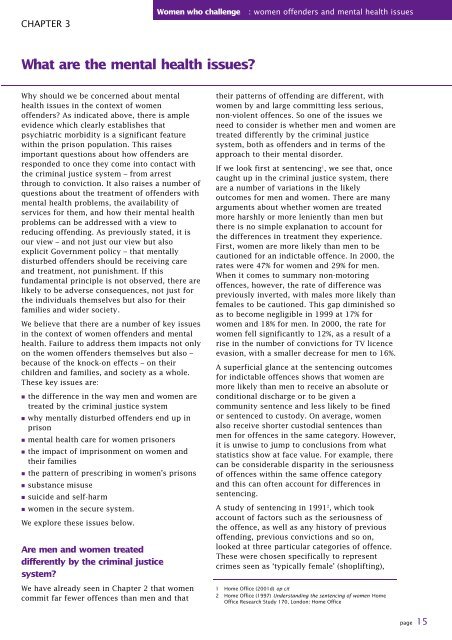Women who challenge - Nacro
Women who challenge - Nacro
Women who challenge - Nacro
- No tags were found...
Create successful ePaper yourself
Turn your PDF publications into a flip-book with our unique Google optimized e-Paper software.
CHAPTER 3<strong>Women</strong> <strong>who</strong> <strong>challenge</strong>: women offenders and mental health issuesWhat are the mental health issues?Why should we be concerned about mentalhealth issues in the context of womenoffenders? As indicated above, there is ampleevidence which clearly establishes thatpsychiatric morbidity is a significant featurewithin the prison population. This raisesimportant questions about how offenders areresponded to once they come into contact withthe criminal justice system – from arrestthrough to conviction. It also raises a number ofquestions about the treatment of offenders withmental health problems, the availability ofservices for them, and how their mental healthproblems can be addressed with a view toreducing offending. As previously stated, it isour view – and not just our view but alsoexplicit Government policy – that mentallydisturbed offenders should be receiving careand treatment, not punishment. If thisfundamental principle is not observed, there arelikely to be adverse consequences, not just forthe individuals themselves but also for theirfamilies and wider society.We believe that there are a number of key issuesin the context of women offenders and mentalhealth. Failure to address them impacts not onlyon the women offenders themselves but also –because of the knock-on effects – on theirchildren and families, and society as a <strong>who</strong>le.These key issues are:• the difference in the way men and women aretreated by the criminal justice system• why mentally disturbed offenders end up inprison• mental health care for women prisoners• the impact of imprisonment on women andtheir families• the pattern of prescribing in women’s prisons• substance misuse• suicide and self-harm• women in the secure system.We explore these issues below.Are men and women treateddifferently by the criminal justicesystem?We have already seen in Chapter 2 that womencommit far fewer offences than men and thattheir patterns of offending are different, withwomen by and large committing less serious,non-violent offences. So one of the issues weneed to consider is whether men and women aretreated differently by the criminal justicesystem, both as offenders and in terms of theapproach to their mental disorder.If we look first at sentencing 1 , we see that, oncecaught up in the criminal justice system, thereare a number of variations in the likelyoutcomes for men and women. There are manyarguments about whether women are treatedmore harshly or more leniently than men butthere is no simple explanation to account forthe differences in treatment they experience.First, women are more likely than men to becautioned for an indictable offence. In 2000, therates were 47% for women and 29% for men.When it comes to summary non-motoringoffences, however, the rate of difference waspreviously inverted, with males more likely thanfemales to be cautioned. This gap diminished soas to become negligible in 1999 at 17% forwomen and 18% for men. In 2000, the rate forwomen fell significantly to 12%, as a result of arise in the number of convictions for TV licenceevasion, with a smaller decrease for men to 16%.A superficial glance at the sentencing outcomesfor indictable offences shows that women aremore likely than men to receive an absolute orconditional discharge or to be given acommunity sentence and less likely to be finedor sentenced to custody. On average, womenalso receive shorter custodial sentences thanmen for offences in the same category. However,it is unwise to jump to conclusions from whatstatistics show at face value. For example, therecan be considerable disparity in the seriousnessof offences within the same offence categoryand this can often account for differences insentencing.A study of sentencing in 1991 2 , which tookaccount of factors such as the seriousness ofthe offence, as well as any history of previousoffending, previous convictions and so on,looked at three particular categories of offence.These were chosen specifically to representcrimes seen as ‘typically female’ (shoplifting),1 Home Office (2001d) op cit2 Home Office (1997) Understanding the sentencing of women HomeOffice Research Study 170, London: Home Officepage 15
















